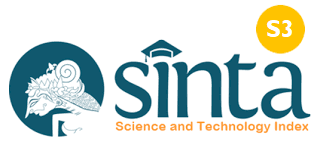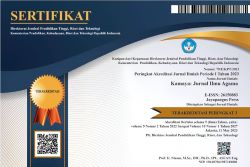Studi Korelasi Metode Silent Sitting Dan Meditasi Cahaya Terhadap Konsentrasi Belajar Siswa Di Sekolah Dasar Sathya Sai Denpasar
Keywords:
Silent Sitting, Light Meditation, Learning ConcentrationAbstract
The purpose of this research is to analyze the comparison between the theory obtained in college and the reality in the field. The specific objective was to analyze the relationship between Silent Sitting and Light Meditation on the concentration of student at SD Sathya Sai Denpasar. This research uses observation, interview and questionnaire methods with data collection instruments in the form of questionnaires and statistical analysis methods with multiple regression analysis formulas. The research sample used a sampling technique (proportional random sampling) with a sample size of 23 students. Processing data using multiple regression analysis formulas and data analysis using computer assistance through the SPSS version 11.00 for Windows. The rule of the decision is to use a significance level (a 0.05), if r count is more> t table, then Ho is rejected, meaning there is a significant relationship. Conversely, if r count <t table, then Ho is accepted, it means that there is no significant relationship.
The findings of the research, the coefficient of determination (R²) = 0.64. Guided by the correlation coefficient interpretation table, the value of 0.64 states that there is a strong relationship between variables. This means that the relationship between Silent Sitting and Light Meditation on the concentration of student at SD Sathya Sai Denpasar is strong. The contribution of Silent Sitting and Light Meditation methods is 64%. Thus, it can be concluded that the Silent Sitting and Light Meditation methods can make students concentrate on learning.
References
Gunawan. (2015). Pembelajaraan Kooperatif dengan Media Virtual Untuk Peningkatan Penguasaan Konsep Fluida Statis Siswa. Jurnal Pendidikan Fisika. Mataram : Universitas Mataram
Kintari, F. (2014). Pengaruh Konsentrasi Belajar Dan Kreatifitas Belajar Terhadap Prestasi Belajar Akuntansi Siswa Kelas XI IPS Di SMA Muhamadiyah1 Sragen Tahun Ajaran 2013/1014. Skripsi (tidak diterbitkan). Jurusan Pendidikan Akuntansi. Surakarta:Universitas Muhamadiyah Surakarta.
Margolis. (1990). Pengaruh Yoga Terhadap Konsentrasi Belajar Siswa. Jurnal Psikologi: Universitas Udayana.
Melly, G. (2012). Revolt Into Style : The Silent Sitting. Faber & Faber
Nuryadi. (2012). Pengaruh Model Pembelajaran Quantum dengan Pendekatan Realistic Mathematic Education Terhadap Kemampuan Berpikir Kreatif dan Motivasi Belajar Siswa. Jurnal Edukasi Matematika. Madiun : Universitas PGRI Madiun
Setiawati, E. & Ariyanta. (2015). Metode Educare sebagai Media Spiritualitas Balvikas dalam Spirit Multikulturalisme. Jurnal Penelitian : Vidya Samhita
Surya, H. (2009). Menjadi Manusia Pembelajar. Jakarta : PT. Elex Media Komputindo
Susanto. (2006). Faktor-Faktor yang Berkaitan dengan Perilaku Kewirausahaan Pedagang Kakilima. Jurnal Penyuluhan. Bogor
Surya, H. (2004). Kiat Mengatasi Kesulitan Belajar. Jakarta: PT Gramedia.
Yupardhi, W. S. (2004). Kebahagiaan di Balik Tantangan dan Penderitaan (Pengalaman Spiritual di Dunia Maya). Surabaya: Paramita.
Wibawa. (2005). Meditasi Cahaya; Melihat di Dalam Dirimu. Surabaya : Paramita
Downloads
Published
How to Cite
Issue
Section
License
An author who publishes in the Kamaya : Jurnal Ilmu Agama agrees to the following terms:
- Author retains the copyright and grants the journal the right of first publication of the work simultaneously licensed under the Creative Commons Attribution-ShareAlike 4.0 License that allows others to share the work with an acknowledgement of the work's authorship and initial publication in this journal
- Author is able to enter into separate, additional contractual arrangements for the non-exclusive distribution of the journal's published version of the work (e.g., post it to an institutional repository or publish it in a book) with the acknowledgement of its initial publication in this journal.
- Author is permitted and encouraged to post his/her work online (e.g., in institutional repositories or on their website) prior to and during the submission process, as it can lead to productive exchanges, as well as earlier and greater citation of the published work (See The Effect of Open Access).
Read more about the Creative Commons Attribution-ShareAlike 4.0 Licence here: https://creativecommons.org/licenses/by-sa/4.0/.





